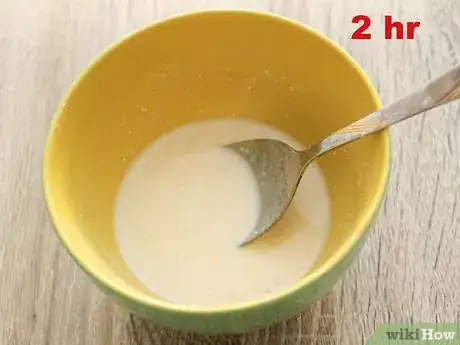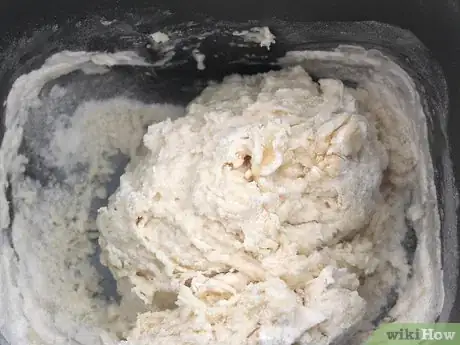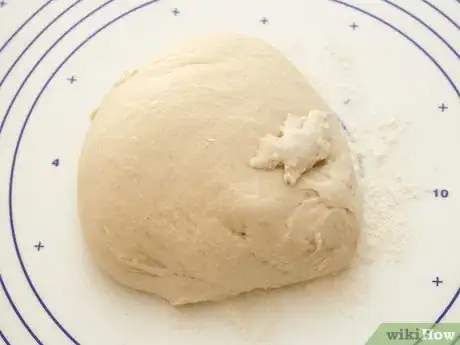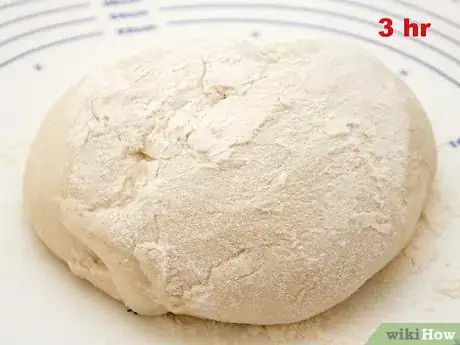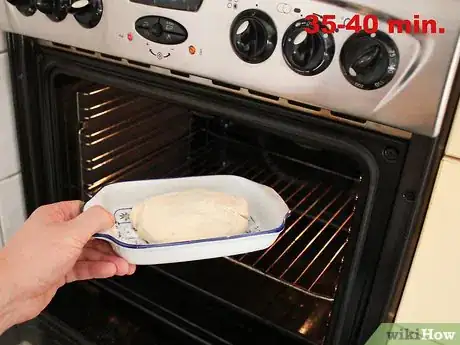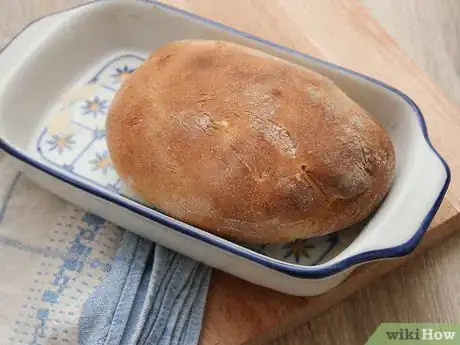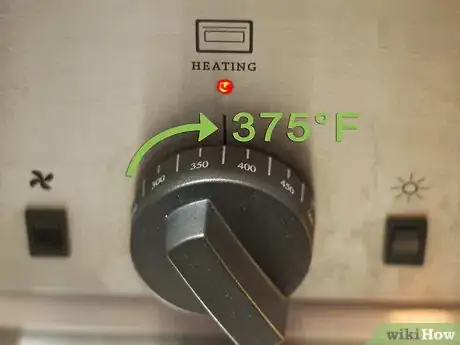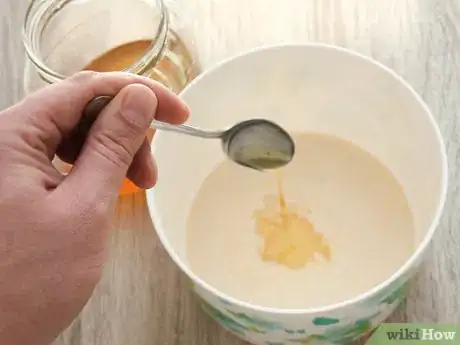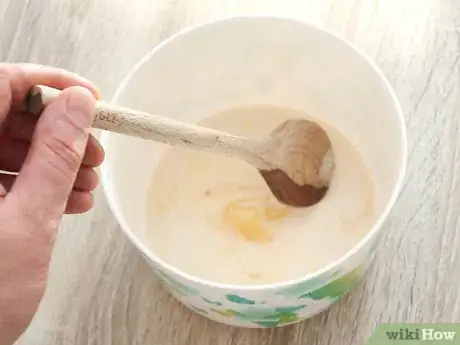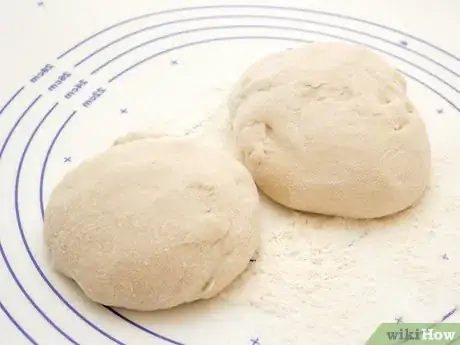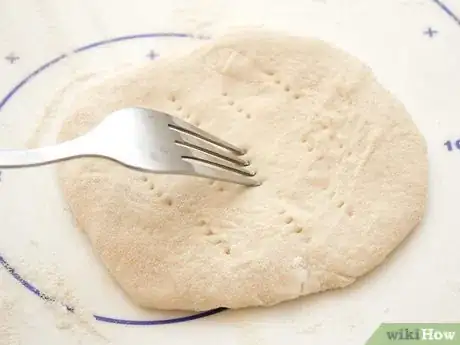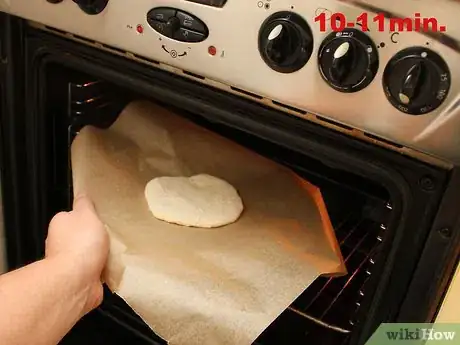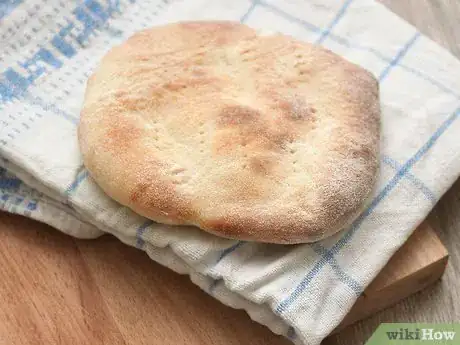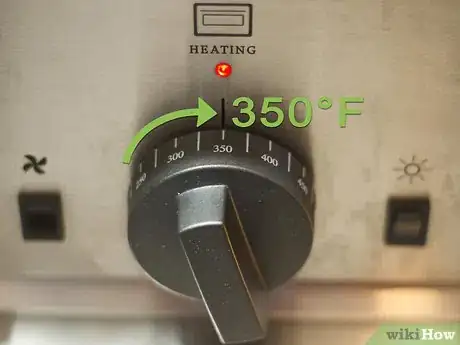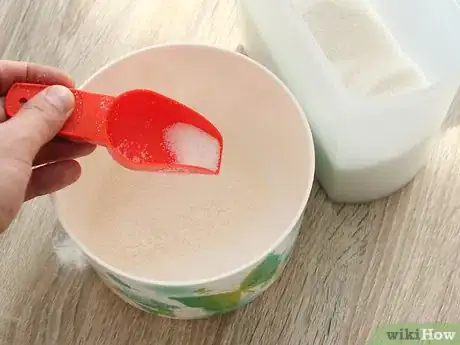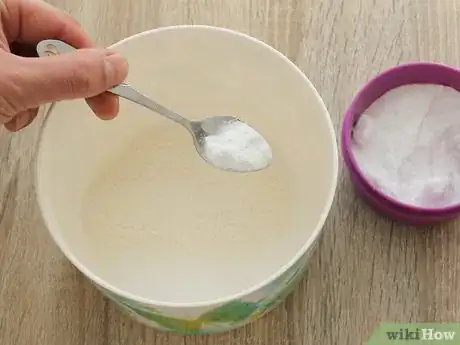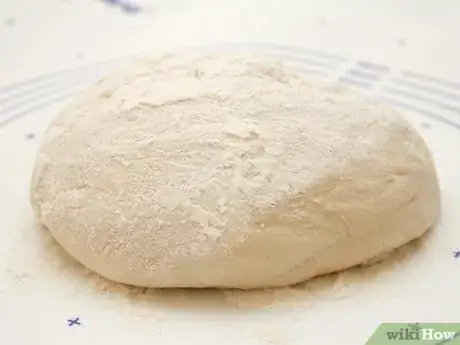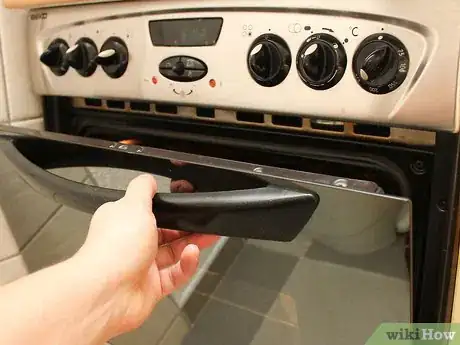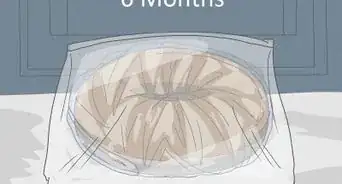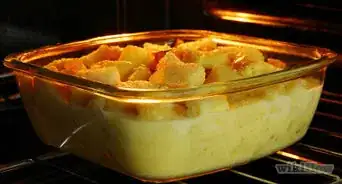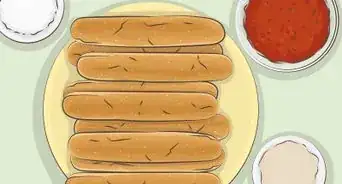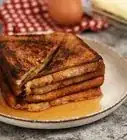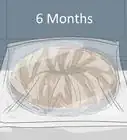wikiHow is a “wiki,” similar to Wikipedia, which means that many of our articles are co-written by multiple authors. To create this article, volunteer authors worked to edit and improve it over time.
There are 8 references cited in this article, which can be found at the bottom of the page.
This article has been viewed 93,972 times.
Learn more...
Most traditional bread recipes require the use of yeast, but if you have an allergy to yeast or would otherwise like to avoid using this finicky ingredient, there are other ways to bake bread. Some recipes rely on other ingredients, like baking soda or self-rising flour, to give the bread lift, while others don’t use any leavening ingredients at all.
Ingredients
Makes 1 loaf
Starter One
- 3 tsp (15 ml) cornmeal
- 1 tsp (5 ml) all-purpose flour
- 1/8 tsp (0.5 ml) baking soda
- 1/2 cup (125 ml) scalded milk
Starter Two
- 2 cups (500 ml) warm water
- 1-1/2 cups (375 ml) all-purpose flour
Dough
- 1 cup (250 ml) warm water
- 2-1/2 cups (625 ml) all-purpose flour
Makes 10 to 12 servings
- 1 cup (250 ml) cold water
- 1/4 cup (60 ml) vegetable oil
- 1/2 cup (125 ml) honey
- 1-1/2 tsp (7.5 ml) salt
- 1 egg
- 4 to 5 cups (1 to 1.25 L) bread flour OR all-purpose flour
Makes 1 loaf
- 2-1/2 cups (625 ml) self-rising flour
- 3 Tbsp (45 ml) white granulated sugar
- 12 fl oz (355 ml) lemon-lime carbonated soda
Steps
Pioneer (Salt-Rising) Bread
-
1Combine the first starter ingredients. Place the cornmeal, 1 tsp (5 ml) flour, and baking soda in a 1-qt (1-L) glass jar. Pour the scalded milk on top of the dry ingredients, then stir or whisk the contents together until smooth.[1]
- To prepare the scalded milk, heat it on the stove or in the microwave until small bubbles form around the edge of the dish. Steam may develop, but you should not allow the milk to reach a rolling boil. Allow the milk to cool to a lukewarm temperature before adding it to the dry ingredients.[2]
-
2Keep the starter warm overnight. Cover the jar and let it stand for 8 to 12 hours in a warm place away from any drafts.
- Ideally, the starter should be kept at a temperature around 105 degrees Fahrenheit (40 degrees Celsius).
- Place the jar in your oven with the heat off, but turn the oven light on. Note that you may need to turn the light on up to two hours ahead of time to get the oven adequately warm.
- Alternatively, try wrapping a kitchen towel around the jar and placing it in a paper bag. Keep the wrapped jar in the warmest part of your kitchen.
Advertisement -
3Combine the first starter with the second. Once the starter develops bubbly foam and a pungent fermented odor, transfer it to a medium mixing bowl. Add the 2 cups (500 ml) of warm water and 1-1/2 cups (375 ml) of flour, then stir until smooth.
- At this stage, the starter should have the consistency of a thin pancake batter.
-
4Let the combined starter become foamy. Loosely cover the bowl with plastic wrap and return it to the warm place used previously. Allow the starter to rise for another 2 hours.
- The starter needs to maintain the same warm temperature it previously had. It should bubble and nearly double in volume.
-
5Add the dough ingredients. Transfer the starter to larger bowl, then add 1 cup (250 ml) of warm water and about 2-1/2 cups (425 ml) of flour. Mix the ingredients until a stiff dough forms.
- You may need to vary the amount of flour by 1/2 cup (125 ml) either way to achieve the right consistency.
- Knead the dough in the bowl until it becomes soft and elastic.
-
6Shape the dough into a loaf. Lightly grease the bottom and sides of a small loaf pan with cooking spray, then shape the dough into a loaf and set it inside.
- Use an 8-1/2 inch by 4-1/2 inch (21.5 cm by 11.5 cm) loaf pan.
-
7Let the dough rise. Return the dough to the previously used warm spot and allow it to rise for another 3 hours, or until it climbs about 1/2 inch (1.25 cm) above the top of the pan.
- Near the end of the rising time, preheat the oven to 350 degrees Fahrenheit (175 degrees Celsius).
-
8Bake for 35 to 40 minutes. Place the pan in your preheated oven and allow the bread to bake until it turns light golden brown in color.
- Note that the bread typically won't rise much as it bakes.
- If you gently tap on the outer crust, the bread should have a slight hollow sound once it's ready.
-
9Enjoy. Remove the bread from the oven and turn it out onto a cooling rack after about 5 minutes. Serve the bread once it becomes cool enough to handle.
- You should be able to stare this bread at room temperature for about a week or in the refrigerator for two weeks. You can also freeze it for long-term storage.
Unleavened Bread (Egg Matzah)
-
1Preheat the oven to 375 degrees Fahrenheit (190 degrees Celsius).[3] Prepare two baking sheets by lining them with parchment paper.
- If desired, you could lightly coat the baking sheets with nonstick cooking spray instead of using parchment paper. Aluminum foil can be used, as well, but the bottom of the bread may brown quicker with foil.
-
2Combine the water, oil, honey, egg, and salt. In a large mixing bowl, stir the five ingredients together until evenly mixed.
- You can substitute half to all of the oil with melted butter if you prefer the taste. Other cooking oils, like canola oil, may also be used instead of standard vegetable oil.
- Press on the yolk of the egg with the mixing spoon to break it before mixing the ingredients. Doing so will make it easier to blend the yolk into the rest of the mixture.
-
3Slowly mix in the flour. Add the flour to the rest of the ingredients 1 cup (250 ml) at a time, mixing well after each addition to fully incorporate the flour. Continue until you've blended in at least 4 cups (1 L) of flour, then knead the flour in the bowl until it forms a stiff, cohesive, and elastic dough.
- Bread flour and all-purpose flour will both work for this recipe, but note that bread flour will create a denser product.
- You can add up to 5 cups (1.25 L) of flour total if the dough seems too sticky with less, but adding too much can make the dough too dense.
-
4Divide the dough.[4] Using your hands, separate the dough into two even halves. Then, separate each half in half again, forming quarters. Divide each quarter into three equally sized balls.
- Alternatively, you can separate the dough into three or four large portions and cut these portions down to size after rolling the dough flat. Either option will work, so stick with whichever feels easiest for you.
-
5Roll out each piece. Pat each ball of dough in between your hands, forming it into a flat patty. To make the dough even thinner, roll these patties out using a lightly floured rolling pin.
- Your hands should be lightly coated with flour, oil, or cooking spray before you handle the dough. Otherwise, the dough will likely stick to your fingers, creating a mess.
- If working with large portions instead of individual portions, you'll need to use the rolling pin.
- Ideally, the dough should be rolled out to a thickness of about 1/4 inch (6 mm), but you can leave the dough as thick as about 3/4 inch (2 cm) if desired. Note that thicker bread requires a longer cooking time, however.
-
6Poke holes in the surface. Using the tines of a regular fork, poke even rows of holes across the surface of each dough portion, leaving no more than 1 inch (2.5 cm) of space in between rows.
- If you left the dough in large portions, use a sharp knife or pizza cutter to divide the dough into about 12 evenly sized rectangles at this time.
-
7Bake until golden brown. Place the individual portions of dough on your prepared baking sheets, then sit them inside the preheated oven. Bake the bread for about 10 to 11 minutes, or until lightly browned around the edges and over the surface.
- If the bread is 1/4 inch (6 mm) thin, it should be ready within 10 to 11 minutes. For bread 1/2 inch (1.25 cm) thick, bake it for about 13 to 14 minutes. Bread as thick as 3/4 inch (2 cm) may need 15 to 20 minutes.
- Watch the bread carefully as it bakes. If it cooks for too long, it can easily become hard and unpleasant.
-
8Serve. Remove the finished bread from the oven and transfer it to wire racks until cooled to room temperature. Enjoy it while it's fresh for the best flavor.
- You should be able to store this bread in an airtight container or plastic bag for several days.
Lemon-Lime Soda Bread
-
1Preheat the oven to 350 degrees Fahrenheit (175 degrees Celsius). Meanwhile, prepare a 9-inch by 5-inch (23-cm by 13-cm) loaf pan by lightly greasing the bottom and sides with nonstick cooking spray or shortening.
- Alternatively, you can use two 8-inch by 4-inch (20-cm by 10-cm) loaf pan. Make sure that the total loaf pan volume can hold 8 cups (2 L).[5]
- To further prevent sticking, consider lightly dusting the bottom of the pan with a little flour after greasing it.
- You may also use parchment paper, but using aluminum foil since the foil can cause quicker browning and uneven cooking for this recipe.
-
2Combine the flour and sugar. In a large bowl, mix together the flour and sugar until evenly combined.
- Depending on your personal sense of taste and the lemon-lime soda used, you may need to alter the amount of sugar. If you have a notably sweet soda or prefer blander bread, cut the sugar back by 1 Tbsp (15 ml). If you have a mild soda or strongly prefer very sweet bread, consider adding another 1 Tbsp (15 ml) of sugar.
-
3Mix in the lemon-lime soda.[6] Pour the carbonated soda over the dry ingredients and mix well using a mixing spoon or clean hands. Lightly knead the dough in the bowl until it comes together.
- Note that the dough will likely be somewhat lumpy.[7] Do not attempt to knead out all the lumps since over-mixing the dough can cause problems with the finished texture.
- For a blander bread, consider using club soda instead of lemon-lime soda.
- You can experiment further by using different flavors of carbonated soda, but each different flavor will have a different effect on the final taste of the bread.
-
4Form the loaf. Transfer the dough into your prepared loaf pan. Use your hands to spread it out evenly over the entire pan. Pat on the top surface to flatten it out.
- If using two loaf pans instead of one, evenly divide the dough between the two.
-
5Bake for 45 to 60 minutes. Place the filled loaf pan in the oven and bake the bread until the top turns light golden-brown. This will usually happen after 45 minutes, but some ovens may require additional bake time.
-
6Serve. Remove the finished bread from the oven. After 10 minutes, remove the loaf from the pan and allow it to continue cooling on a wire rack. Enjoy slightly warm to room temperature.
- The finished bread will be somewhat crumbly and chewy, with a flavor somewhat reminiscent of homestyle biscuits. You can slice it thin or thick.
Warnings
- Note that egg matzah is not kosher for the Passover Seder, and matzah made with water and other liquids (including oil and eggs) should not be prepared at all during Passover. The matzah consumed during Passover must be "poor bread" made of only flour and water.[8]⧼thumbs_response⧽
Things You’ll Need
Pioneer (Salt-Rising) Bread
- 1-qt (1-L) glass jar
- Plastic wrap
- Small saucepan or microwave-safe dish
- Dish towel
- Medium mixing bowl
- Large mixing bowl
- Whisk or mixing spoon
- 8-1/2 inch by 4-1/2 inch (21.5 cm by 11.5 cm) loaf pan
Unleavened Bread (Egg Matzah)
- Baking sheets
- Parchment paper
- Large mixing bowl
- Mixing spoon
- Rolling pin
- Fork
Lemon-Lime Soda Bread
- 9-inch by 5-inch (23-cm by 13-cm) loaf pan
- Large mixing bowl
- Mixing spoon
- Nonstick cooking spray
References
- ↑ http://www.npr.org/sections/thesalt/2014/04/23/305659383/bake-bread-like-a-pioneer-in-appalachia-with-no-yeast
- ↑ http://www.kingarthurflour.com/recipes/classic-american-salt-rising-bread-recipe
- ↑ http://recipesforourdailybread.com/unleavened-communion-bread-recipe/
- ↑ http://www.catholicicing.com/baked-unleavened-bread-with-kids/
- ↑ http://www.joyofbaking.com/PanSizes.html
- ↑ http://allrecipes.com/recipe/7087/yeast-free-bread/
- ↑ http://www.cooks.com/recipe/e45064wb/sprite-soda-bread.html
- ↑ http://www.chabad.org/holidays/passover/pesach_cdo/aid/1163475/jewish/Is-Egg-Matzah-Kosher-For-Passover.htm
About This Article
To make bread without yeast, start by whisking together cornmeal, flour, baking soda, and scalded milk to make the starter for the dough. Then, leave the mixture in a warm spot overnight, or until it develops a bubbly foam and a fermented odor. Next, stir in warm water and flour, then cover the starter with plastic wrap and return it to the warm spot for at least 2 hours. Once it’s doubled in size, add the rest of the warm water and flour, then knead the dough and shape it into a loaf. Let it rise for 3 hours, then bake it for 35-40 minutes in a 350 degree Fahrenheit oven. To learn how to make egg matzah or lemon-lime soda bread, keep reading!



